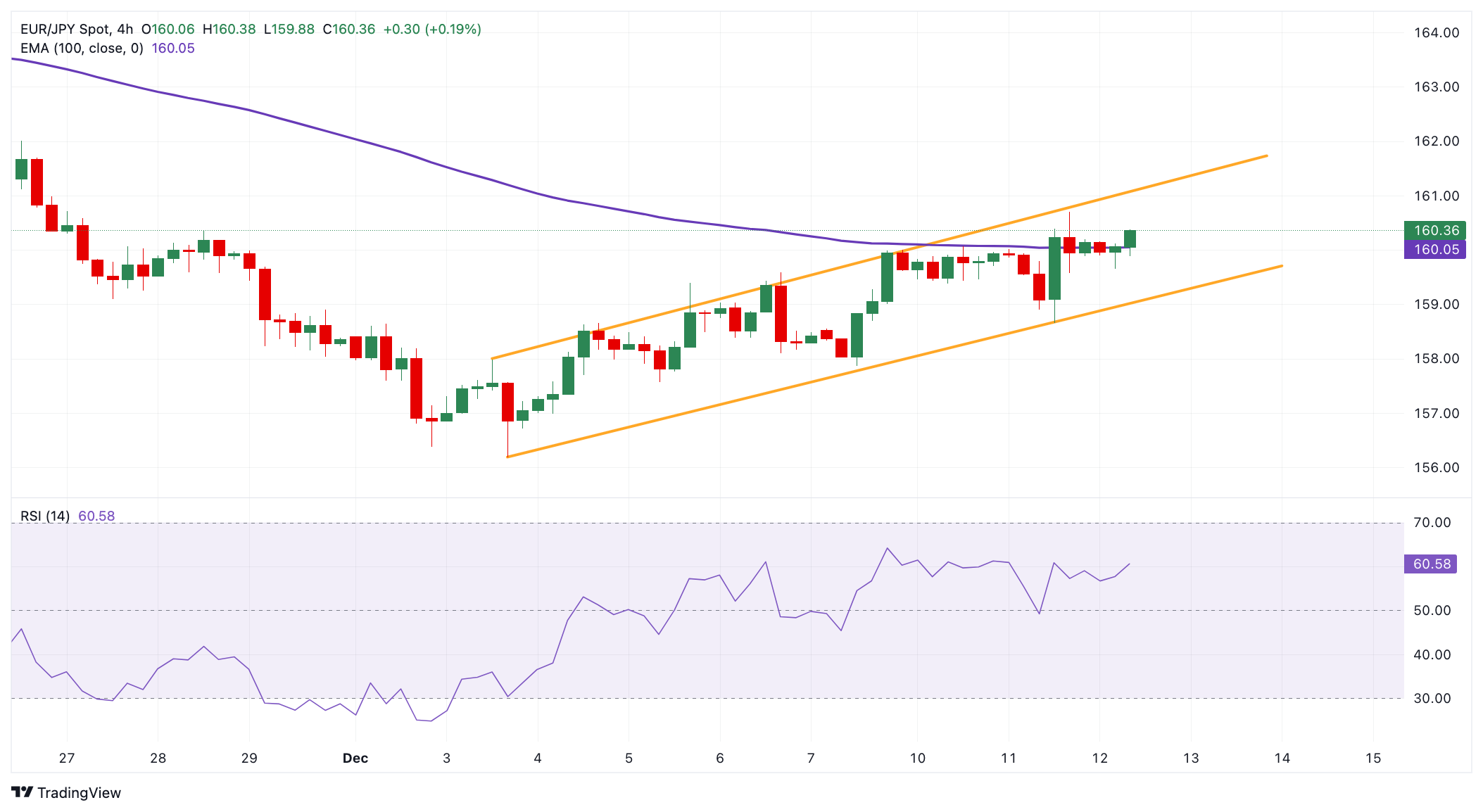- EUR/JPY extends the recovery towards 160.35 in the European session on Thursday, adding 0.15% on the day.
- The cross resumes an uptrend above the key 100 EMA with the RSI indicator bullish.
- The immediate resistance level is located at 160.70; The crucial support level emerges at the psychological level of 160.00.
The EUR/JPY cross is trading in positive territory for the fourth consecutive day around 160.35 during the European session on Thursday. The Japanese Yen (JPY) weakens after Reuters reported on Thursday that the Bank of Japan (BoJ) is considering keeping interest rates steady at its December meeting next week. One source said, “Policymakers would rather spend more time examining overseas risks and clues about next year’s wage prospects.” Later on Thursday, investors will closely monitor the European Central Bank’s (ECB) interest rate decision.
Technically, EUR/JPY resumes its uptrend on the 4-hour chart as the price crosses above the key 100 EMA. The bullish momentum is supported by the Relative Strength Index (RSI), which stands above the midline near 59.45, supporting the short-term buyers.
The first upside barrier to the crossover emerges at 160.70, the December 11 high. A sustained trade above this level could pave the way towards 161.10, the upper boundary of the uptrend channel. The next potential resistance level is seen at 162.00, which represents the November 26 high and the round figure.
On the other hand, a break of the psychological level of 160.00 could drag the cross towards 159.10, the lower boundary of the trend channel. Any additional selling below the mentioned level could see a drop towards 158.65, the December 11 low.
EUR/JPY 4-hour chart
The Euro FAQs
The Euro is the currency of the 19 countries of the European Union that belong to the eurozone. It is the second most traded currency in the world, behind the US dollar. In 2022, it accounted for 31% of all foreign exchange transactions, with an average daily turnover of more than $2.2 trillion per day. EUR/USD is the most traded currency pair in the world, accounting for an estimated 30% of all transactions, followed by EUR/JPY (4%), EUR/GBP (3%) and EUR/AUD (2 %).
The European Central Bank (ECB), headquartered in Frankfurt, Germany, is the reserve bank of the eurozone. The ECB sets interest rates and manages monetary policy. The ECB’s primary mandate is to maintain price stability, which means controlling inflation or stimulating growth. Its main tool is the increase or decrease in interest rates. Relatively high interest rates (or the expectation of higher rates) tend to benefit the euro and vice versa. The Governing Council of the ECB makes decisions on monetary policy at meetings held eight times a year. Decisions are made by the directors of the Eurozone’s national banks and six permanent members, including ECB President Christine Lagarde.
Eurozone inflation data, measured by the Harmonized Index of Consumer Prices (HICP), are an important econometric indicator for the euro. If inflation rises more than expected, especially if it exceeds the ECB’s 2% target, it forces the ECB to raise interest rates to bring it back under control. Relatively high interest rates compared to their counterparts tend to benefit the euro, making the region more attractive as a place for global investors to park their money.
The published data measures the health of the economy and may have an impact on the euro. Indicators such as GDP, manufacturing and services PMIs, employment and consumer confidence surveys can influence the direction of the single currency. A strong economy is good for the Euro. Not only does it attract more foreign investment, but it may encourage the ECB to raise interest rates, which will directly strengthen the euro. Otherwise, if economic data is weak, the Euro is likely to fall. Economic data for the four largest eurozone economies (Germany, France, Italy and Spain) are especially significant, as they represent 75% of the eurozone economy.
Another important data that is published about the Euro is the trade balance. This indicator measures the difference between what a country earns from its exports and what it spends on imports during a given period. If a country produces highly in-demand export products, its currency will gain value simply from the additional demand created by foreign buyers seeking to purchase those goods. Therefore, a positive net trade balance strengthens a currency and vice versa in the case of a negative balance.
Source: Fx Street
I am Joshua Winder, a senior-level journalist and editor at World Stock Market. I specialize in covering news related to the stock market and economic trends. With more than 8 years of experience in this field, I have become an expert in financial reporting.






